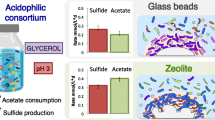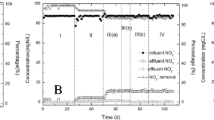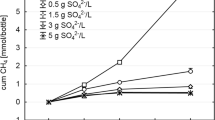Abstract
Soda lakes are characterized by an intense sulfur cycle that begins with sulfidogenesis. Model laboratory experiments that involved combining of pure cultures showed that, during anaerobic decomposition of cellulose by Clostridium alkalicellulosi, the sulfate-reducing bacteria (SRB) of the species Desulfonatronovibrio hydrogenovorans, Desulfonatronum lacustre, and Desulfonatronum cooperativum, different in their nutritional requirements, may directly use the cellulose fermentation products for sulfidogenesis without mediatory microorganisms. In binary cocultures with SRB, the amount of the H2S formed constituted from one-third to two-thirds of the cellulose [H] equivalents; acetate was among the products formed. When the syntrophic Contubernalis alkalaceticum, capable of acetate oxidation, was incorporated into the trophic chain along with hydrogenotrophic SRB, the amount of the H2S formed exceeded by 33–42% the amount of the [H] equivalents in the utilized cellulose, water being the source of additional hydrogen. Thus, the trophic pathway from plant residues to sulfide, previously considered to be the longest in the alkaliphilic microbial community, may involve a minimal number of stages and do without intermediate participation of dissipotrophic fermenting organisms.
Similar content being viewed by others
References
Zavarzin, G.A. and Zhilina, T.N., Genus Desulfonatronovibrio, Bergey’s Manual of Systematic Bacteriology, Second Ed., vol. 2: The Proteobacteria, part C: The Alpha-, Beta-, Delta-, and Epsilonproteobacteria, Brenner D.J., Krieg N.R., Staley J.T., Garrity G.M. Eds, New York: Springer, 2005, pp. 953–955.
Zhilina, T.N., Genus Desulfonatronum, Bergey’s Manual of Systematic Bacteriology, Second Ed., vol. 2: The Proteobacteria, part C: The Alpha-, Beta-, Delta-, and Epsilonproteobacteria, Brenner D.J., Krieg N.R., Staley J.T., Garrity G.M. Eds, New York: Springer, 2005, pp. 956–958.
Foti, M., Sorokin, D.Y., Lomans, B., Mussman, M., Zacharova, E.E., Pimenov, N.V., Kuenen, J.G., and Muyzer, G., Diversity, Activity, and Abundance of Sulfate-Reducing Bacteria in Saline and Hypersaline Soda Lakes, Appl. Environ. Microbiol., 2007, vol. 73, pp. 2093–2100.
Gorlenko, V.M., Anoxygenic Phototrophic Bacteria of Soda Lakes, Trudy Instituta mikrobiologii im. S.N. Winogradskogo. Vyp. XIV, (Proceedings of the Winogradsky Institute of Microbiology, Issue XIV), Moscow: Nauka, 2007.
Sorokin, D.Y. and Kuenen, J.G., Haloalkaliphilic Sulfur-Oxidizing Bacteria in Soda Lakes, FEMS Microbiol. Rev., vol. 29, pp. 685–702.
Kevbrin, V.V., Zhilina, T.N., and Zavarzin, G.A., Decomposition of Cellulose by the Anaerobic Alkaliphilic Microbial Community, Mikrobiologiya, 1999, vol. 68, no.5 [Microbiology (Engl. Transl.), vol. 68, no. 5, pp. 601–609].
Garnova, E.S., Zhilina, T.N., Tourova, T.P., and Lysenko, A.M., Anoxynatronum sibiricum gen. nov., sp. nov., Alkaliphilic Saccharolytic Anaerobe from Cellulolytic Community of Nizhnee Beloe (Transbaikal Region), Extremophiles, 2003, vol. 7, pp. 213–220.
Garnova, E.S., Zhilina, T.N., Tourova, T.P., Kostrikina, N.A., and Zavarzin, G.A., Anaerobic, Alkaliphilic, Saccharolytic Bacterium Alkalibacter saccharofermentans gen. nov., sp. nov. from a Soda Lake in the Transbaikal Region of Russia, Extremophiles, 2004, vol. 8, pp. 309–316.
Zhilina, T.N., Appel, R., Probian, Ch., and Brossa, E., L., Harder J., Widdel F., and Zavarzin G.A., Alkaliflexus imshenetskii gen. nov., sp. nov. — a New Alkaliphilic Gliding Carbohydrate-Fermenting Bacterium with Propionate Formation from a Soda Lake, Arch. Microbiol., 2004, vol. 182, pp. 244–253.
Zhilina, T.N., Zavarzina, D.G., Kuever, J., Lysenko, A.M., and Zavarzin, G.A., Desulfonatronum cooperativum sp. nov., a Novel Hydrogenotrophic, Alkaliphilic, Sulfate-Reducing Bacterium, from a Syntrophic Culture Growing on Acetate, Int. J. Syst. Evol. Microbiol., 2005, vol. 55, pp. 1001–1006.
Zhilina, T.N., Kevbrin, V.V., Tourova, T.P., Lysenko, A.M., Kostrikina, N.A., and Zavarzin, G.A., Clostridium alkalicellum sp. nov., an Obligately Alkaliphilic Cellulolytic Bacterium from a Soda Lake in the Baikal Region, Mikrobiologiya, 2005, vol. 74, pp. 642–653 [Microbiology (Engl. Transl.), vol. 74, pp. 557–566].
Zhilina, T.N., Zavarzina, D.G., Kolganova, T.V., Tourova, T.P., and Zavarzin, G.A., “Candidatus Contubernalis alkalaceticum,” an Obligately Syntrophic Alkaliphilic Bacterium Capable of Anaerobic Acetate Oxidation in a Coculture with Desulfonatronum cooperativum, Mikrobiologiya, 2005, vol. 74, pp. 800–809 [Microbiology (Engl. Transl.), vol. 74, pp. 695–703].
Pikuta, E.V., Zhilina, T.N., Zavarzin, G.A., Kostrikina, N.A., Osipov, G.A., and Rainey, F.A., Desulfonatronum lacustre gen. nov., sp. nov.: A New Alkaliphilic Sulfate-reducing Bacterium Utilizing Ethanol, Mikrobiologiya, 1998, vol. 67, pp. 123–131 [Microbiology (Engl. Transl.), vol. 67, pp. 105–113].
Pikuta, E.V., Lysenko, A.M., and Zhilina, T.N., Distribution of Desulfonatronovibrio hydrogenovorans in Soda Lakes of Tuva, Mikrobiologiya, 1997, vol. 66, pp. 262–268 [Microbiology (Engl. Transl.), vol. 66, pp. 216–221].
Kevbrin, V.V. and Zavarzin, G.A., Effect of Sulfur Compounds on the Growth of the Halophilic Homoacetogenic Bacterium Acetohalobium arabaticum, Mikrobiologiya, 1992, vol. 61, pp. 812–817.
Trüper, H.G. and Schlegel, H.G., Sulfur Metabolism in Thiorhodaceae. I. Quantitative Measurements on Growing Cells of Chromatium okenii, Antonie van Leeuwenhoek, 1964, vol. 30, pp. 225–238.
Minkevich, I.G., Material’no-energeticheskii balans i kinetika rosta mikroorganizmov (Matter and Energy Balance and Kinetics of Microbial Growth), Moscow-Izhevsk: NITs “Regulyatornaya i khaoticheskaya dinamika,” 2005.
Gorlenko, V.M., Namsaraev, B.B., Kulyrova, A.V., Zavarzina, D.G., and Zhilina, T.N., The Activity of Sulfate-Reducing Bacteria in Bottom Sediments of Soda Lakes of the Southeastern Transbaikal Region, Mikrobiologiya, 1999, vol. 68, pp. 664–670 [Microbiology (Engl. Transl.), vol. 68, pp. 580–585].
Sorokin, D.Y., Gorlenko, V.M., Namsaraev, B.B., Namsaraev, Z.B., Lysenko, A.M., Eshinimaev, B.T., Khmelenina, V.N., Trotsenko, Y.A., and Kuenen, J.G., Prokaryotic Communities of the North-Eastern Mongolian Soda Lakes, Hydrobiologia, 2004, vol. 522, pp. 235–248.
Author information
Authors and Affiliations
Corresponding author
Additional information
Original Russian Text © G.A. Zavarzin, T.N. Zhilina, L.E. Dulov, 2008, published in Mikrobiologiya, 2008, Vol. 77, No. 4, pp. 472–482.
Rights and permissions
About this article
Cite this article
Zavarzin, G.A., Zhilina, T.N. & Dulov, L.E. Alkaliphilic sulfidogenesis on cellulose by combined cultures. Microbiology 77, 419–429 (2008). https://doi.org/10.1134/S0026261708040061
Received:
Accepted:
Published:
Issue Date:
DOI: https://doi.org/10.1134/S0026261708040061




